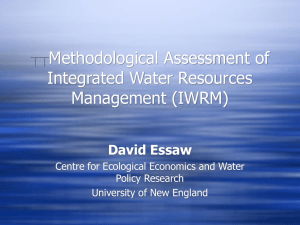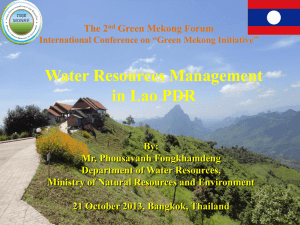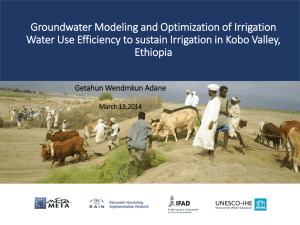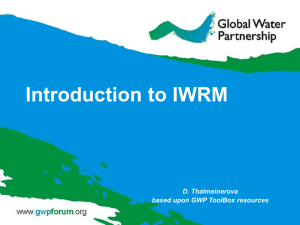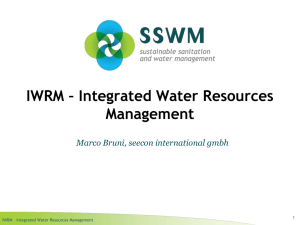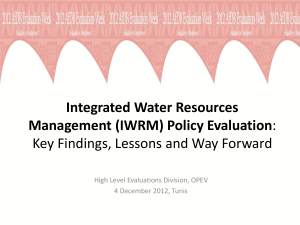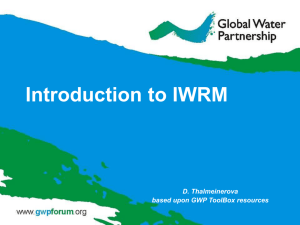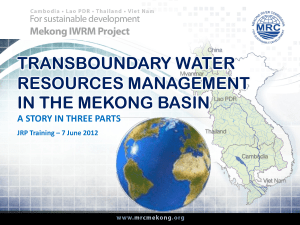Campana_WSDHM_Talk_9_April_2014
advertisement
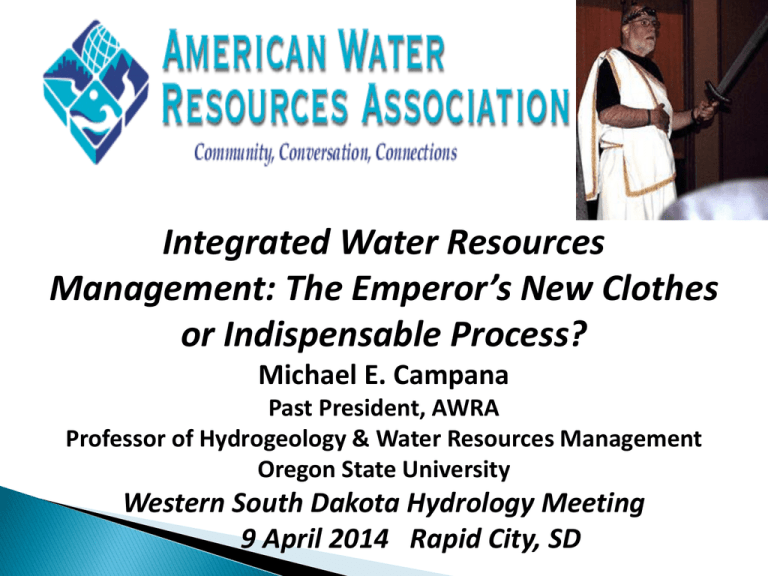
Integrated Water Resources Management: The Emperor’s New Clothes or Indispensable Process? Michael E. Campana Past President, AWRA Professor of Hydrogeology & Water Resources Management Oregon State University Western South Dakota Hydrology Meeting 9 April 2014 Rapid City, SD Thanks! Introduction to IWRM Emperor & Water King Two Recent Water Books Background and ‘Watershed’ Events AWRA & IWRM Activities; What is IWRM? Oregon’s Integrated Water Resources Strategy New Mexico Water Planning Resources & Activities: AWRA & USACE Misgivings: Juggernauts & Groundwater My Take Brenda O. Bateman, OWRD & AWRA Ari Michelsen, Texas A&M & AWRA Wayne S. Wright, GeoEngineers & AWRA Steven L. Stockton, Dir., Civil Works, USACE Ada L. Benavides, USACE HQ John R. Wells, MN Env. Quality Board & AWRA Lisa Beutler, MWH Global & AWRA John C. Tracy, Idaho WRRI & AWRA Ken Reid, AWRA Executive VP Dick Engberg, AWRA Technical Director Mary F. Campana, Spouse & Librarian Extraordinaire He’s Baaack! The Emperor of IWRM! Integrated Water Resources Management: The Emperor’s New Clothes or Indispensable Process? The Water King’s (Emperor’s Evil Twin) 3 Commandments! 1)“A fool and water will go go the way they are diverted.” – African proverb 2) “Nothing is impossible for the man who doesn’t have to do it himself.” 3) Bottled water = $3.2M/acre-foot (see #1) Born in Manhattan (NY, not KS). Grew up on Long Island, NY. Left East for good in 1970 (one year of penance @ GA State University in Atlanta, early 1980s) Undergraduate degree in Geology – College of William & Mary in Williamsburg, VA (Class of 1970) Learned my water (hydrology - MS & PhD; mathematics minor) at U. of Arizona – emphasis on groundwater hydrology Spent virtually entire adult life (1970 – 2006) living and working (Desert Research Institute and U of NM) in arid West (AZ, NV, CA, NM). Rehydration: western Oregon since 2006 (c. 1 meter precipitation/year) International work: Central America, South Caucasus, Central Asia, Egypt, Europe Favorite compliment (depending upon who says it): ‘You don’t sound like an academic!’ 1975: Finished graduate work in hydrology at U of AZ. Desert Research Institute (1976-89); UNM (1989-2006) Mid-1990s: went over to “dark side” - policy, management, etc. Hung out/worked with economists, sociologists, lawyers, et al. Appreciated multidisciplinary/interdisciplinary approaches to water. Married Mary Frances in 1993 (support!) Late 1990s: Started focusing on WaSH (water, sanitation, and hygiene) issues in developing regions. Volunteer work with Lifewater International and Living Water International. 2001-2005: Started traveling with students to Honduras to work on gravity-flow water systems. Promoted ‘hydrophilanthropy’. 2002: Founded 501(c)(3) - Ann Campana Judge Foundation (www.acjfoundation.org) – funds and undertakes water/sanitation projects in Central America 2006: Social Media – Blog, Twitter, LinkedIn, Facebook; OSU arrival; headed Institute for Water & Watersheds through 2009. AWRA & IWRM Activities What Is IWRM? Multidisciplinary AWRA: well-suited to IWRM Held Four Water Policy Dialogues http://is.gd/aIjto0 Water Resources IMPACT issue in May 2011; Webinars; Two Reports Conducted large survey of water professionals on IWRM 2006 IWRM Policy Statement adopted 2011 Organized International Specialty Conferences on IWRM in 2011and 2014 Established IWRM Award in 2012 What is ‘integrated? From Dictionary.com: 1. Combining or coordinating separate elements so as to provide a harmonious, interrelated whole: an integrated plot; an integrated course of study. 2. Organized or structured so that constituent units function cooperatively: an integrated economy. 3. Having, including, or serving members of different racial, religious, and ethnic groups as equals: an integrated school. Compare segregated. 4. Sociology. Of or pertaining to a group or society whose members interact on the basis of commonly held norms or values. 5. Psychology. Characterized by integration. Integrated Water Resources Management (IWRM) is a process which promotes the coordinated development and management of water, land and related resources in order to maximise economic and social welfare in an equitable manner without compromising the sustainability of vital ecosystems and the environment. – Global Water Partnership [http://is.gd/7l3kZD] Operationally, IWRM approaches involve applying knowledge from various disciplines as well as insights from diverse stakeholders to devise and implement efficient, equitable and sustainable solutions to water and development problems (GWP 2000; http://www.gwp.org/) Comprehensive (integrated) Participatory Planning and implementation tool Balances social and economic needs Ensures protection of ecosystems for future generations Oregon’s Integrated Water Resources Strategy Developing Oregon’s Statewide Integrated Water Resources Strategy Oregon’s House Bill 3369 (2009) • Directed OWRD to lead efforts to “understand and meet” Oregon’s water needs” • Partner with water quality, fish & wildlife, agriculture, other agencies, tribes, stakeholders, & public • Account for coming pressures (climate change, population, land use issues) instream and out-of-stream …quality, quantity & ecosystem needs …today and in the future Oregon’s Integrated Water Resources Strategy (http://is.gd/injzOC) • Adopted in August 2012 • Serves as Oregon’s blueprint for meeting instream and out-of-stream needs • Covers 13 issue areas • Contains more than 40 recommended actions Researching Neighboring States Developed a Discussion Paper & Draft Guidelines (https://bitly.com/1ou046g) California IRWM Texas Regional Planning Washington Watershed Planning Our Foundation – What We Know Already Oregon’s Place-Based IWRM Plans should: Recognize the public interest in water Maintain state authorities and responsibilities for management of water resources; plans must comply with existing state laws and requirements Include a meaningful process for public involvement, with public meetings Include balanced representation of all interests Be integrated, addressing instream and out-of-stream needs, including water quantity, water quality, and ecosystem needs Account for groundwater and surface water (e.g., interaction) Delineate and describe local population centers, key industries, and listed fish species, among many other factors that influence the use and management of water 2012 IWRS , p. 80-81 New Mexico Water Planning Resources & Activities: AWRA & USACE • • • • • Certification program offers a commitment to the principles of IWRM Standards and criteria for US water resources projects at all levels (fed, regional, state and local) Increase understanding of the benefits of IWRM principles and projects that meet this approach (Congress, OMB…) USACE expects to have program developed by AWRA June 2014 25 • • • • USACE is committed to incentivize the use of IWRM as a holistic approach to solve the Nation’s water resources challenges 10 projects will be evaluated against criteria A multi-purpose, objective outcomes, stakeholders, basin/watershed based criteria November 2014 (AWRA) 26 Case Studies in Integrated Water Resources Management: From Local Stewardship to National Vision A Report by the Policy Committee of the American Water Resources Association Download: http://is.gd/3qgfZl Additional IWRM Resources ($$): http://is.gd/gzZcW2 Proactive Flood and Drought Management Report: A Selection of Applied Strategies and Lessons Learned from Around the United States A Report by the Policy Committee of the American Water Resources Association Download: http://is.gd/M7hlja Additional IWRM Resources ($$): http://is.gd/gzZcW2 USACE Report: Understanding Integrated Water Resources Management (IWRM) Download: http://is.gd/8Ih143 Watertoolbox.us One Stop Shop Data Portal Leading Edge Models and Tools Collaboration Connection June 2011- Snowbird, UT - Integrated Water Resources Management: The Emperor’s New Clothes or Indispensable Process? http://is.gd/xLa7UC Symposium on Collaborative Modeling & IWRM at Snowbird: http://is.gd/u4f8zp Water Resources IMPACT issue: http://is.gd/21QTGj Summer 2014 Conference: IWRM – From Theory to Application, 30 June – 2 July, Reno, NV http://is.gd/THmAha Misgivings: Juggernauts & Groundwater ◦ 'From IWRM Back to Integrated Water Resources Management’ paper by Mark Giordano & Tushaar Shah (http://is.gd/CpBt1h) An IWRM juggernaut? “Integrated water resources management provides a set of ideas to help us manage water more holistically. However, these ideas have been formalized over time in what has now become, in capitals, Integrated Water Resources Management (IWRM), with specific prescriptive principles whose implementation is often supported by donor funding and international advocacy. IWRM has now become an end in itself, in some cases undermining functioning water management systems, in others setting back needed water reform agendas, and in yet others becoming a tool to mask other agendas. Critically, the current monopoly of IWRM in global water management discourse is shutting out alternative thinking on pragmatic solutions to existing water problems.” IWRM – key aspects: •Sustainability •Watershed is often used as the ‘management unit’ Groundwater: •Sustainably pumped? •Boundaries? •Nonrenewability – an issue •Limited replenishment (recharge) •Limited replenishment, large storage •Replenished, but over long time scales •Water is mined (abstraction > R) •Polluted •‘Decoupled’ from hydrologic cycle My Take •Use of the watershed scale and sustainability requirement could preclude inclusion of nonrenewable groundwater in IWRM. •However, as water resources become further stressed by climate change, population growth, etc., nonrenewable groundwater will become more important as a water source, if only as a buffer or temporary supply. •Recommendation: We do need to consider NR GW as a component of IWRM and devise ways to manage it, perhaps in conjunction with Managed Aquifer Recharge (MAR). You can certainly (and should) support and practice integrated water resources management without buying into the IWRM juggernaut. If you want to call what you do IWRM, I don't have a problem with that. To me, IWRM is an abbreviation describing a process. I like how Giordano and Shah conclude their paper: "As Elinor Ostrom and her colleagues concluded a decade ago: (1) there is no one best system for governing water resources; and (2) many more viable options exist for resource management than envisioned in much of the policy literature. (Ostrom, Stern, & Dietz, 2003). We need to put the problems first and then work to find pragmatic solutions, whether they use IWRM principles or not." Mark Giordano and Tushaar Shah WaterWired blog: http://www.waterwired.org Twitter: http://twitter.com/waterwired Favorite rant – Groundwater: The 'Rodney Dangerfield' of the Hydrologic Cycle http://bit.ly/uYE8B1 “Water is the Rubik’s Cube of public policy.” – John Laird, California Resources Secretary (suggests there is a solution!) “We learn nothing from history except that we learn nothing from history.” – Cicero “The road to help is paved with good intentions.” - Tracy Baker
